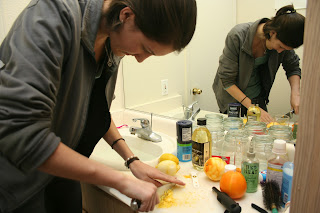 Yesterday I turned in my last final of the term and I'm officially on spring break for one short, glorious week and a half. Well, I still have to go to work today, but as far as school is concerned, I'm on spring break! It's a little bittersweet, because this is my last spring break ever, but I have big plans to make it memorable. Surprisingly, these plans aren't "sit on my bum and watch Star Trek all day."
Yesterday I turned in my last final of the term and I'm officially on spring break for one short, glorious week and a half. Well, I still have to go to work today, but as far as school is concerned, I'm on spring break! It's a little bittersweet, because this is my last spring break ever, but I have big plans to make it memorable. Surprisingly, these plans aren't "sit on my bum and watch Star Trek all day."(Don't worry, this will get to food... eventually.)
One of the things I've been trying very hard to do during finals is be thankful for what I have. Finals and work stress really, really get to me in the worst way, so I've been trying to remind myself of the good things to help calm me down. I first thought of this when I was drawing a thank you card for some relatives that helped me out with spring break plans (and also to procrastinate on studying for finals, but mostly because I was grateful).
 |
| The secret to drawing awesome cards? Draw in pencil first, then ink it in with a gel/ballpoint pen. When the ink is dry, erase pencil marks and fill in empty spaces. |
I'm incredibly lucky to be employed as I work my way through college, and even luckier to be employed somewhere that values creativity. (No, seriously: Check out this pitch my boss wrote!) Sometimes the commute can get me down, but then I'm treated to the most amazing skies and the drive doesn't seem bad at all. I mean, just take a look:
And of course, I'm thankful for my readers! You guys are awesome...
I'm also thankful my mom taught me to make French toast, and I'm deeply thankful for this French toast, because it's freaking delicious. I use Semifreddi's cinnamon challah swirl as the base, but it's tasty with any kind of bread. Plain challah, Italian bread like pugliese or ciabatta, French bread, sourdough sandwich bread, cinnamon raisin bread — all kinds of bread are delicious. (I'm hungry, okay? Lists of food are forthcoming.)
First thing is to slice your bread. Thick slices are delicious but will need to be cooked for longer; thinner slices will cook more quickly.
I usually cook the whole loaf and eat the rest for breakfast later in the week. For each two slices of bread, you'll need one egg and a quarter cup of milk, so with 10 slices of bread, I mixed five eggs and a cup and a quarter of milk.
Beat the eggs and milk together as much as you can. If you don't have flavored bread, at this point you can add cinnamon and a little vanilla to the eggs (and nutmeg, if you like it!) to get sweeter French toast, or add dried basil and oregano for a savory version.
Pour a little egg and milk over the bread and let it soak in.
The thicker your bread and slices are, the longer it will take to soak in. My mom actually leaves bread to soak in eggs and milk overnight in the fridge in a 9 by 13 inch pan if she's using pugliese or baguettes. Challah absorbs liquid easily, so it doesn't need to soak too long.
Plop the bread on a medium-high skillet and let it cook. The key here is patience, patience, PATIENCE! When you're cooking French toast, you're essentially cooking an egg inside a slice of bread. Do not sear the outside and let the inside of the bread remain soggy.
Flip when one side is golden brown and looks like a cooked egg. Depending on your skillet heat, this will take about four minutes, but don't worry if it takes longer! If the outside is cooking but the inside is staying soggy, cover your skillet with tin foil (shiny side facing the French toast) to help it cook. When both sides are cooked, serve with real maple syrup and fresh fruit, your favorite jam or honey, or you've made savory French toast, serve with sausage and lemon green beans.
Refrigerate any leftovers to enjoy later! Reheat and spread with peanut butter and jam. Make this French toast for the people in your life you're grateful for, and be thankful for all the delicious varieties of French toast you can make. I certainly am!
French toast
Ingredients:
Bread
Eggs (1 egg per two slices of bread)
Milk (0.25 cups per two slices of bread)
To make:
1. Whisk together milk and eggs.
2. Soak bread in egg/milk mixture.
3. Cook soaked bread on a medium-hot skillet. If the center isn't cooked through, cover the skillet with tin foil.
4. When both sides are cooked, serve with syrup, jam, or fresh fruit.






































